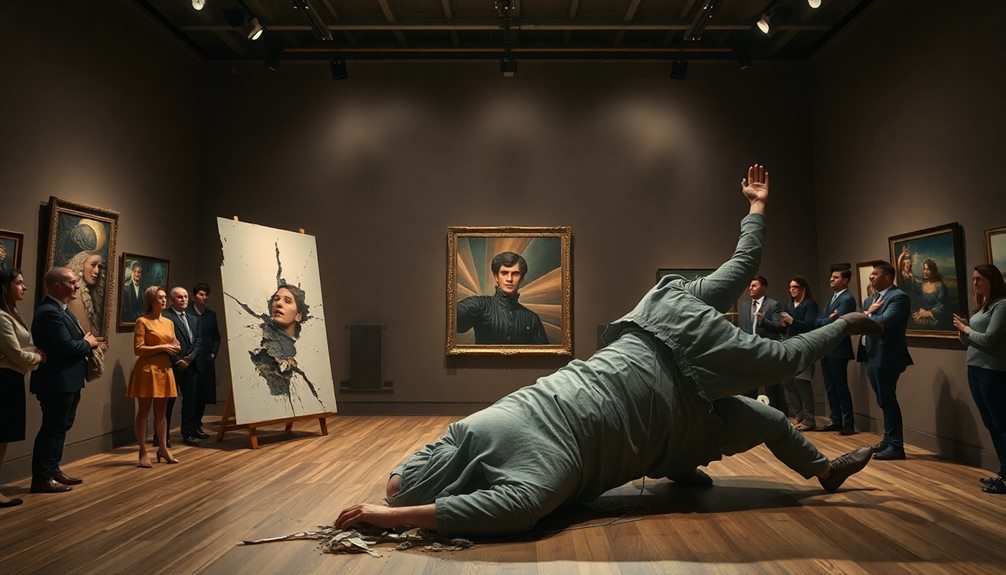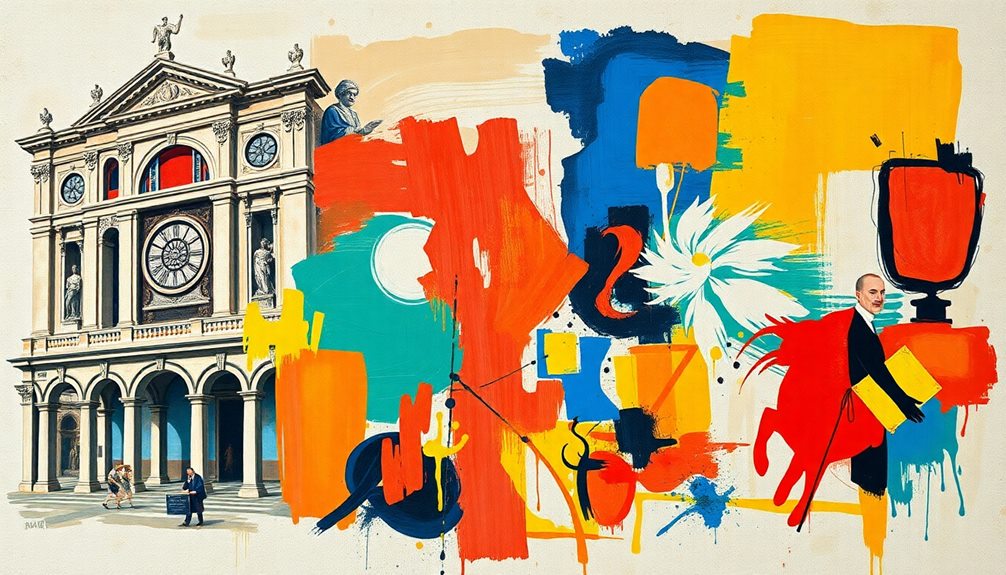Art controversies often spark fierce debates, challenging your perceptions of culture, morality, and artistic intent. Notable examples include Édouard Manet's *Le Déjeuner sur l'Herbe*, which shocked audiences, and Marcel Duchamp's *Fountain*, which redefined art itself. Works like Chris Ofili's *The Holy Virgin Mary* provoke discussions on race and religion, while Ai Weiwei's destruction of a Han Dynasty urn critiques cultural preservation. These controversial pieces reveal the complex dance between art and society. If you're intrigued by the impact of these works, you'll uncover even more fascinating stories as you explore further.
Key Takeaways
- Art controversies often challenge societal norms and provoke discussions, as seen in Manet's *Le Déjeuner sur l'Herbe* and Duchamp's *Fountain*.
- Censorship frequently emerges in response to provocative art, illustrated by the backlash against Chris Ofili's *The Holy Virgin Mary*.
- Artists like Ai Weiwei use controversial actions to critique cultural heritage and political repression, exemplified by his destruction of a Han Dynasty urn.
- Public reception of controversial artworks can lead to backlash, as demonstrated by the outrage surrounding Andres Serrano's *Piss Christ*.
- Social media amplifies debates on art controversies, reflecting modern discussions on commodification and the role of art in society.
Introduction

Art controversies have always sparked intense debates, challenging the boundaries of societal norms and artistic expression. These famous art controversies often arise from works that provoke political discourse or depict graphic content, leading to public outrage and heated discussions.
For instance, Édouard Manet's *Le Déjeuner sur l'Herbe* shocked audiences in 1863 by presenting a nude woman alongside clothed men, marking a significant shift toward Modern Art.
Similarly, Marcel Duchamp's *Fountain* redefined artistic value when he submitted a urinal as art in 1917, prompting ongoing dialogue about what constitutes art.
Chris Ofili's *The Holy Virgin Mary* faced backlash for its controversial use of elephant dung and pornographic imagery, igniting discussions about race and religion in the context of artistic freedom.
Ai Weiwei further challenged perceptions of cultural preservation by dropping a Han Dynasty urn in 1995, critiquing the value placed on historical artifacts.
Each of these instances illustrates how art can push against societal expectations, provoke thought, and stir emotions, highlighting the complex relationship between art, culture, and the values we hold dear.
Key Concepts and Definitions
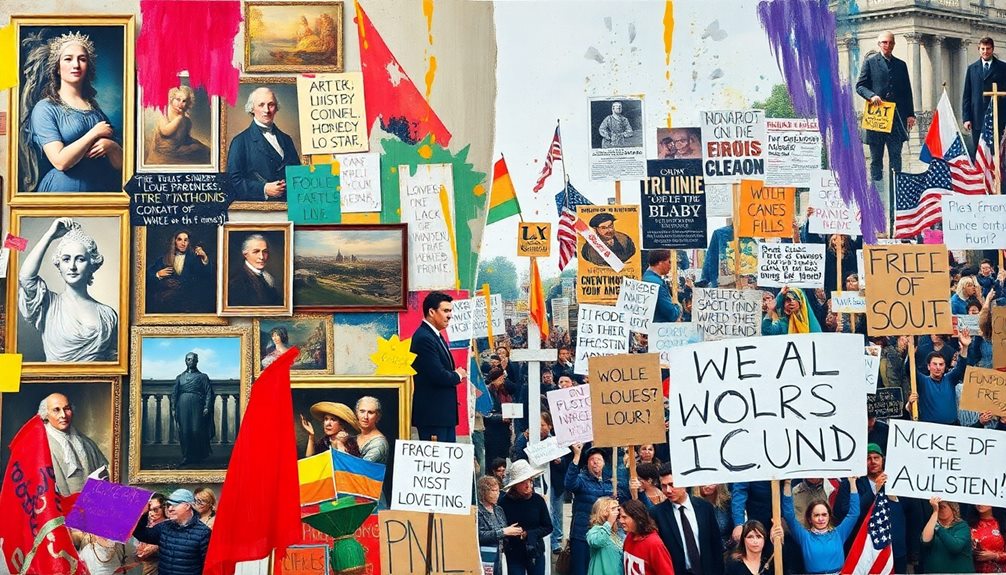
Controversial art often ignites passionate discussions, prompting you to consider the deeper meanings behind the work. This type of art challenges societal norms, often leading to censorship, as seen with Chris Ofili's *The Holy Virgin Mary*. Such pieces provoke strong reactions, ranging from outrage to admiration, influencing public reception and shaping an artist's legacy.
For instance, Marcel Duchamp's *Fountain* initially faced backlash but is now celebrated for its impact on art discourse.
Art as activism plays a crucial role in controversial art, allowing artists like Ai Weiwei to comment on social issues, as demonstrated in *Sunflower Seeds*. The Young British Artists, including Damien Hirst, also utilize shock value to engage audiences, pushing boundaries and sparking debate.
Over time, the cultural significance of controversial works often grows. Pablo Picasso's *Guernica*, which depicts the horrors of war, exemplifies how art can transcend its initial reception and become a powerful symbol.
Understanding these key concepts helps you appreciate the complexities behind controversial art and its enduring influence on society.
Artistic Intent and Impact
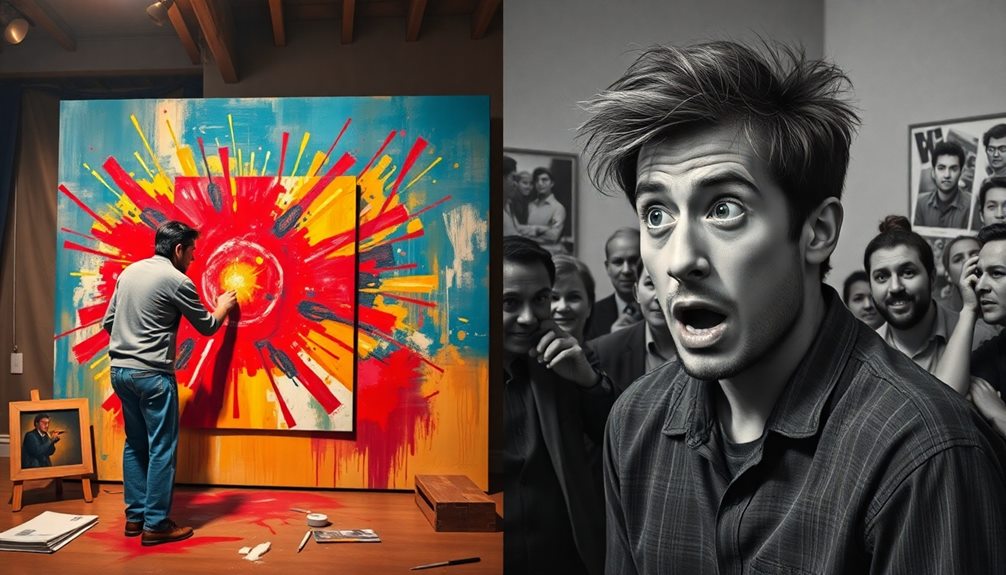
Understanding the complexities of controversial art naturally leads to a closer look at the artistic intent behind these works and their broader impact. Artistic intent often drives the creation of controversial works, challenging cultural norms and sparking provocative discussions.
For instance, Marcel Duchamp's *Fountain* questioned traditional definitions of art, while Ai Weiwei's destruction of a Han Dynasty urn critiqued cultural preservation.
When you explore Damien Hirst's *The Physical Impossibility of Death in the Mind of Someone Living*, you see how it confronts mortality, pushing the boundaries of artistic merit.
Tracy Emin's *My Bed* lays bare personal trauma and vulnerability, redefining artistic intent by addressing female sexuality and emotional expression.
Banksy's *Girl with Balloon* demonstrates how artistic intent weaves into societal commentary. Its self-destruction at auction critiques the commodification of art, revealing the tension between value and meaning.
These examples illustrate that the impact of controversial works goes beyond aesthetics; they challenge perceptions and provoke deeper conversations.
Duchamp's Fountain's Museum Rejection
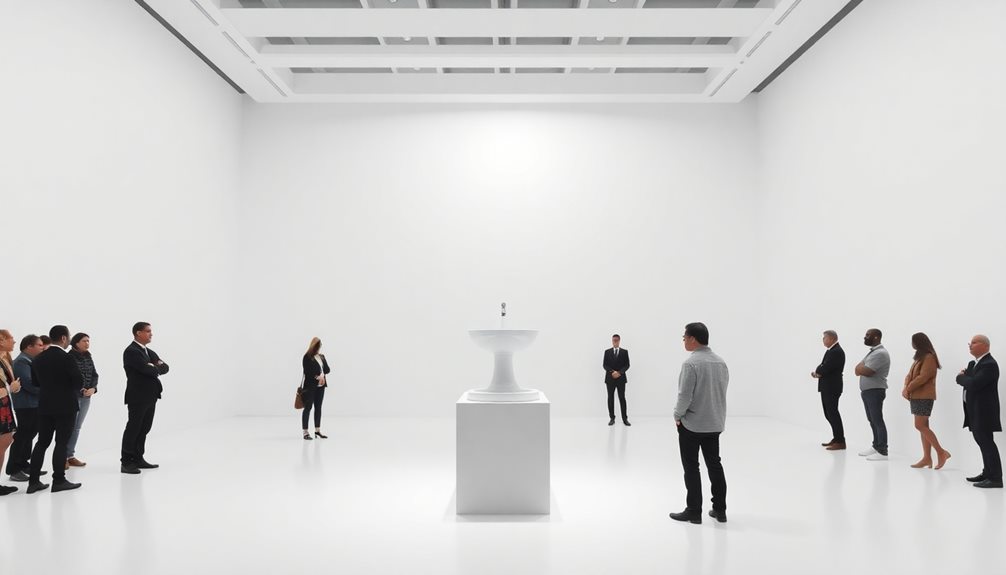
Duchamp's *Fountain* remains a pivotal moment in art history, illustrating the tensions between innovative expression and institutional acceptance. In 1917, Marcel Duchamp submitted this readymade artwork—a porcelain urinal—to the Society of Independent Artists under the pseudonym R. Mutt. Despite the Society's promise to accept all works, *Fountain* faced outright rejection.
This decision ignited a fierce debate about the definition of art and the role of art institutions in shaping that definition. Duchamp's protest against traditional artistic values was clear when he resigned from the Society in response to the rejection. His act was more than a personal statement; it challenged the very norms of artistic expression.
The significance of *Fountain* grew further when Alfred Stieglitz photographed it, solidifying its place in the modern art canon. This incident didn't just highlight a singular rejection; it opened the floodgates for ongoing discussions about the boundaries of artistic expression and the responsibilities of art institutions.
Duchamp's *Fountain* remains a crucial catalyst in the evolution of modern art, prompting you to reconsider what truly defines art in contemporary society.
Tips and Best Practices
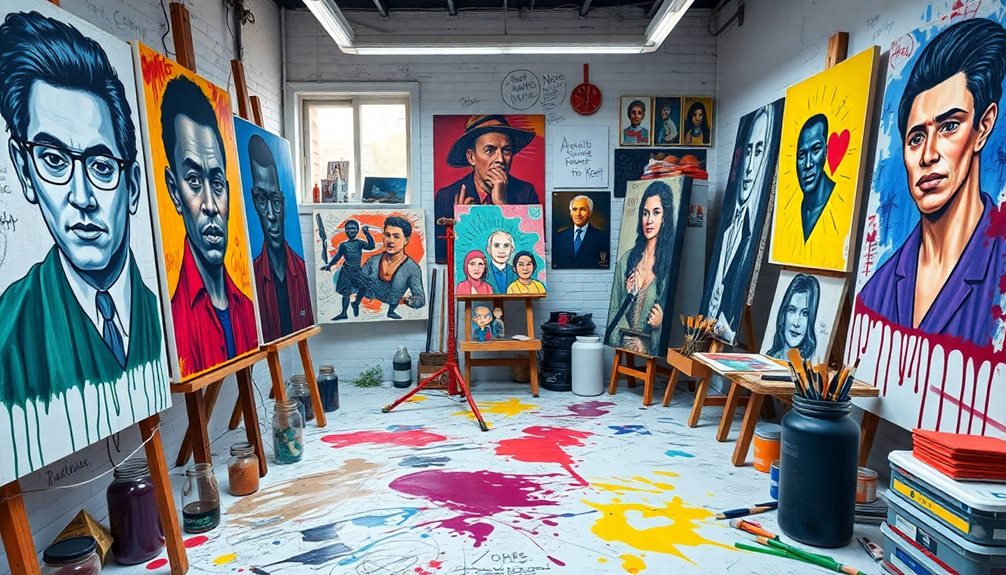
Navigating the complex world of art controversies can be daunting, but staying informed and engaged is essential.
Start by familiarizing yourself with key historical controversies, like Édouard Manet's *Le Déjeuner sur l'Herbe*, which challenges societal norms through its provocative representation of a nude woman.
Understanding the significance of Marcel Duchamp's *Fountain* is crucial, as it redefined what constitutes a work of art and sparked debates about artistic intent in museums.
Explore powerful political statements, such as Picasso's *Guernica*, which highlights the atrocities of war and serves as a focal point for anti-war protests.
Don't overlook contemporary pieces like Damien Hirst's *For the Love of God*; it critiques the intersection of art, morality, and commerce, prompting discussions about value and ethics in the art world.
Viral Social Media Debates
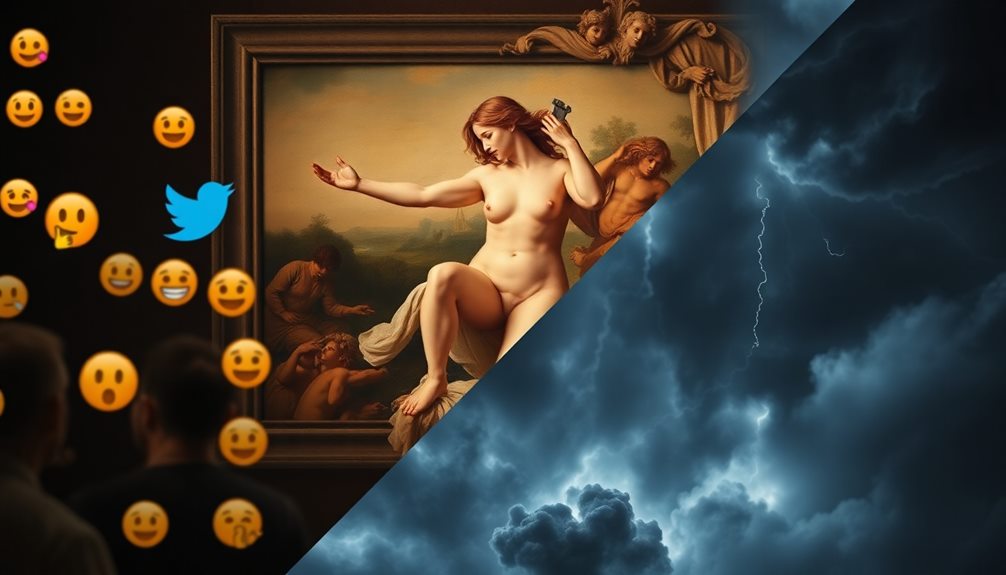
Art controversies have always sparked debates, but the rise of social media has amplified these discussions in unprecedented ways.
You'll find that viral social media debates often center on censorship, with works like Andres Serrano's *Piss Christ* igniting outrage over artistic freedom and blasphemy. Similarly, Banksy's *Girl with Balloon* shredding during an auction opened up discourse on art and commerce, challenging traditional views on artistic worth.
Ai Weiwei's *Sunflower Seeds* generated significant conversation about consumer culture and political repression, highlighting the tension between mass production and individuality.
Meanwhile, Richard Prince's *New Portraits*, which involved rephotographing Instagram images without consent, sparked intense debate over artistic appropriation versus originality, revealing the complexities of art in the digital age.
Tracy Emin's *My Bed* also stirred discussions around personal vulnerability and female sexuality, pushing boundaries of what art can express in contemporary society.
These viral debates not only reflect the diverse perspectives surrounding controversial artists but also underscore the powerful role of social media in shaping discourse around art's place in our lives today.
Public Reception and Backlash
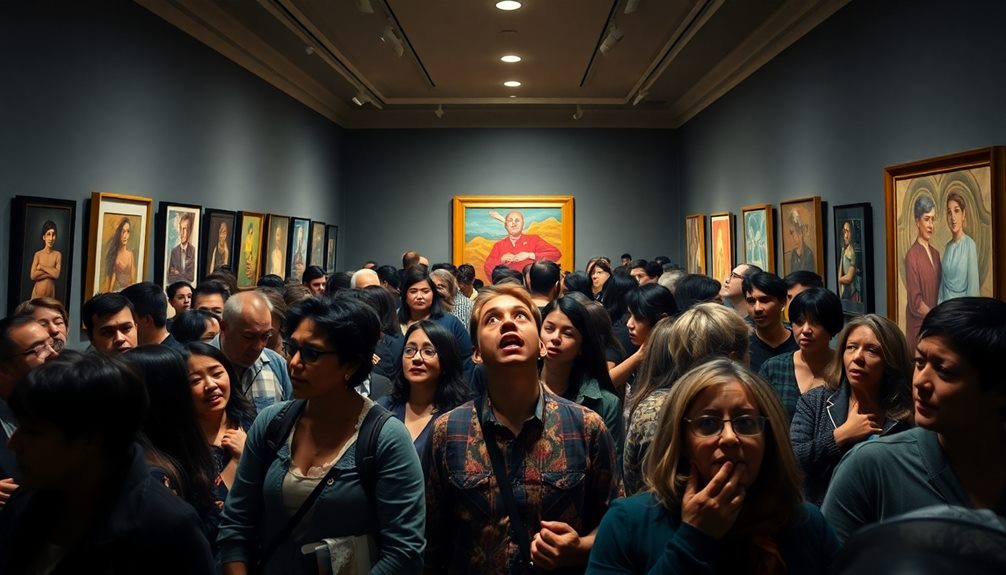
Frequently, public reception to controversial artworks ignites fierce backlash and passionate debates. One of the most renowned controversial pieces, Édouard Manet's "Le Déjeuner sur l'Herbe," shocked Paris in 1863 for depicting a nude woman among clothed men, marking a pivotal moment in art history. This rejection by the Salon triggered discussions about the evolving role of the artist in society.
Fast forward to the 20th century, Marcel Duchamp's "Fountain" challenged art institutions by presenting a urinal as art. Its rejection sparked heated debates about what qualifies as art, reshaping contemporary art dialogues.
Similarly, Andres Serrano's "Piss Christ" faced significant backlash, including threats and vandalism, for its provocative take on religious themes. Chris Ofili's "The Holy Virgin Mary" created outrage with its use of elephant dung and pornographic elements, leading to threats against funding from the city.
Meanwhile, Tracy Emin's "My Bed" elicited mixed reactions, revealing societal discomfort with intimacy and vulnerability. Each of these instances illustrates how provocative artworks can stir public reception, prompting debates that continue to influence the art world, particularly in places like New York.
Additional Resources
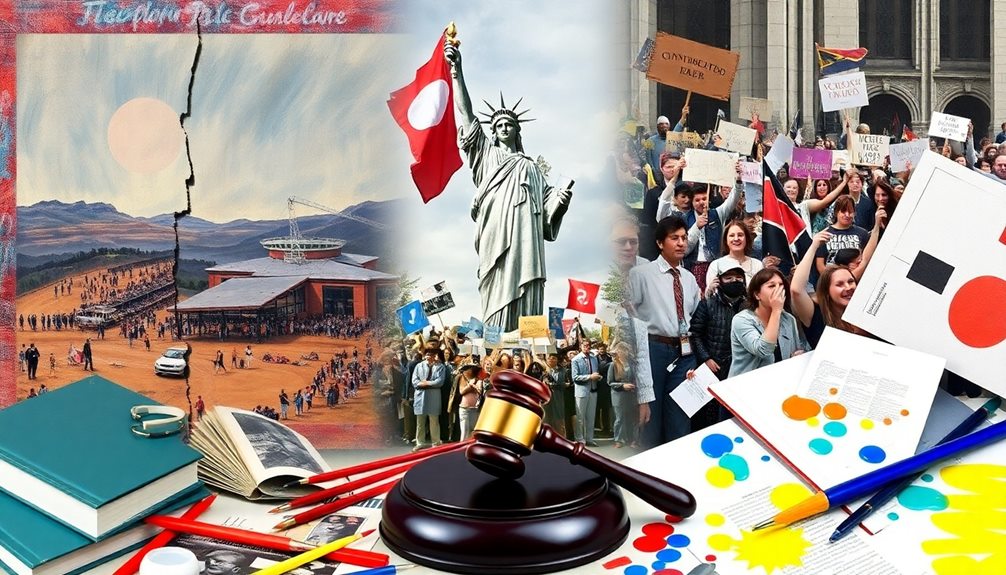
Exploring famous art controversies opens up a treasure trove of resources for deeper understanding and engagement. To dive deeper into the works of art and the artists behind them, consider studying the pivotal moments that shaped modern art.
For instance, examine Édouard Manet's *Le Déjeuner sur l'Herbe*, which challenged societal norms and sparked the controversy surrounding his work in 1863.
Additionally, look into Marcel Duchamp's *Fountain*, a readymade art piece that redefined how we perceive art. Understanding how this work ignited fierce debates can enhance your appreciation for contemporary art discussions.
You'll also find Tracy Emin's *My Bed* a compelling study in vulnerability, representing the Young British Artists movement and its impact on the art world.
Don't overlook Ai Weiwei's provocative act of dropping a Han Dynasty urn, which critiques cultural heritage and authoritarianism.
Frequently Asked Questions
What Are Some Controversial Topics About Art?
When you explore art, you'll encounter controversial topics like censorship, the role of funding, the intersection of art and religion, cultural appropriation, and the boundaries of personal expression. Each discussion reveals deeper societal values and conflicts.
What Is the Most Controversial Art Piece in the World?
You might say Marcel Duchamp's *Fountain* is the most controversial art piece ever. By submitting a urinal as art, he challenged traditional definitions, sparking debates about originality, value, and the very nature of artistic expression.
What Makes an Artwork Controversial?
An artwork becomes controversial when it challenges societal norms, provokes strong emotions, or features political themes. It can also spark debates through rejection, provocative materials, or the artist's background and intentions, igniting public discourse.
What Is the Most Misunderstood Form of Art?
You might find performance art the most misunderstood form of art. It's often seen as mere spectacle, but it deeply explores human interaction, societal boundaries, and personal expression, challenging your perceptions of participation and engagement.
Conclusion
In the world of art, controversies spark conversations that challenge our perceptions and beliefs. By exploring these debates, you gain insight into the power of artistic expression and its impact on society. Whether it's Duchamp's Fountain or modern viral discussions, understanding the nuances behind these controversies enriches your appreciation for art. Embrace the dialogue, stay open-minded, and remember that art's true value often lies in its ability to provoke thought and inspire change. These heated discussions often reveal the diverse perspectives people bring to the table, showcasing how art resonates differently with individuals. When delving into writing tips for sculpture topics, consider exploring the historical, cultural, and emotional dimensions that give these pieces their significance. By doing so, you can craft narratives that not only inform but also evoke deeper connections between readers and the art they encounter.
